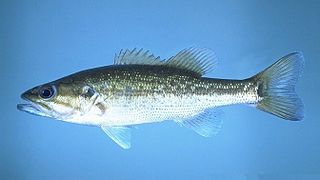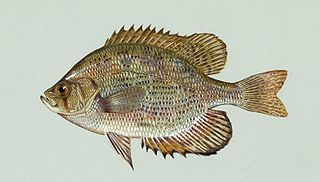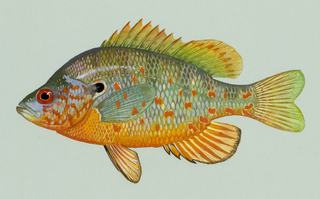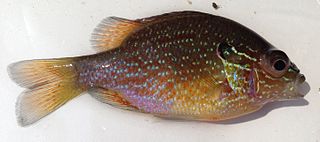
The spotted bass, also called spotty, or spots in various fishing communities, is a species of North American freshwater fish belonging to the sunfish family (Centrarchidae) of the order Perciformes. It is noted for the rows of dark spots below the lateral line, which give it its common name. One of the black basses, it is native to the Mississippi River basin and across the Gulf states, from central Texas through the Florida panhandle. Its native range extends into the western Mid-Atlantic states and it has been introduced into western North Carolina and Virginia. It has also been introduced to southern Africa, where it has become established in some isolated waters as an invasive species.

Centrarchidae, better known as sunfishes, is a family of freshwater ray-finned fish belonging to the order Perciformes, native only to North America. There are eight universally included genera within the centrarchid family: Lepomis, Micropterus, Pomoxis (crappies), Enneacanthus, Centrarchus, Archoplites, Ambloplites, and Acantharchus. A genetic study in 2012 suggests that the highly distinct pygmy sunfishes of the genus Elassoma are also centrarchids.

The bluegill, sometimes referred to as "bream", "brim", "sunny", or, as is common in Texas, "copper nose", is a species of North American freshwater fish, native to and commonly found in streams, rivers, lakes, ponds and wetlands east of the Rocky Mountains. It is the type species of the genus Lepomis, from the family Centrarchidae in the order Perciformes.

The word panfish, also spelled pan-fish or pan fish, is an American English term describing any edible freshwater fish that usually do not outgrow the size of an average frying pan. It is also commonly used by recreational anglers to refer to any small catch that can fit wholly into a pan but still large enough to be legal. The fish species that match this definition and usage vary according to geography. According to the Oxford English Dictionary, the term was first recorded in 1796 in American Cookery, the first known cookbook written by an American author.

Lepomis or true sunfish is a genus of North American freshwater fish from the family Centrarchidae in the order Perciformes. The generic name Lepomis derives from the Greek λεπίς ("scale") and πῶμα. The genus' most recognizable type species is perhaps the bluegill.

The pumpkinseed, also referred to as pond perch, common sunfish, punkie, sunfish, sunny, and kivver, is a small/medium-sized North American freshwater fish of the genus Lepomis, from family Centrarchidae in the order Perciformes.

The rock bass, also known as the rock perch, goggle-eye, red eye, and black perch, is a freshwater fish native to east-central North America. This red-eyed fish is a species of freshwater fish in the sunfish family (Centrarchidae) of order Perciformes and can be distinguished from other similar species by the six spines in the anal fin.

The shadow bass is a species of freshwater fish in the sunfish family (Centrarchidae) of order Perciformes. It is endemic to southeastern United States of America.

The redbreast sunfish is a species of freshwater fish in the sunfish family of the order Perciformes. The type species of its genus, it is native to the river systems of eastern Canada and the United States. The redbreast sunfish reaches a maximum recorded length of about 30 centimetres (12 in).

The green sunfish is a species of aggressive freshwater fish in the sunfish family (Centrarchidae) of order Perciformes. A panfish popular with anglers, the green sunfish is also kept as an aquarium fish by hobbyists, they need a 55-75 gallon tank and can be fed minnows, mealworms, or nightcrawlers. They are usually caught by accident, while fishing for other game fish. Green sunfish can be caught with live bait, such as nightcrawlers, waxworms, mealworms, and blood worms. Grocery store baits, such as pieces of hot dog or corn kernels, can even catch fish. Green sunfish are aggressive and will hit small lures. They can be caught with fly fishing tackle. They are extremely aggressive and will attack swimmers. They usually get 10 inches long, but in some cases they can get 12 inches long.

The longear sunfish is a freshwater fish in the sunfish family, Centrarchidae, of order Perciformes. It is native to the area of eastern North America stretching from the Great Lakes down to northeastern Mexico. The longear sunfish reaches a maximum recorded length of about 24 cm (9.4 in), with a maximum recorded weight of 790 g (1.74 lb). Most do not live beyond six years. The longear sunfish is quite colorful, with an olive to rusty-brown back, bright orange belly and blue-green bars on the sides of its head. A unique characteristic is their elongated operculum flap, giving an appearance of a "long ear".

The redear sunfish, also known as the shellcracker, Georgia bream, cherry gill, chinquapin, improved bream, rouge ear sunfish and sun perch) is a freshwater fish in the family Centrarchidae and is native to the southeastern United States. Since it is a popular sport fish, it has been introduced to bodies of water all over North America. It is known for its diet of mollusks and snails.

The orangespotted sunfish is a North American species of freshwater fish in the sunfish family (Centrarchidae) of order Perciformes. These fish are widely distributed across the middle and eastern United States, from the Rocky Mountains to the east, from the Great Lakes south into the Gulf Coast. The orangespotted sunfish is ecologically unique and thrives in turbid, shallow systems that have few predators and low oxygen contents. The species prefers vegetated areas in sluggish backwaters or lakes, and can also be found in turbid rivers. The orangespotted sunfish can extend its range in lower-quality waters, which is not characteristic to other sunfish. Orangespotted sunfish vary in total length and age for different river basin originations, but can be found to live four to seven years, and recorded lengths are up to 15 cm (5.9 in).
The bluehead shiner is a species of fish in the carp family, Cyprinidae. It is a true minnow. It is endemic to the central United States, where it is found in Arkansas, Louisiana, Texas, and Oklahoma. It was also once known from Illinois.

The golden topminnow is a fish of the genus Fundulus and is a United States native fish mostly distributed throughout the southeast, ranging from Kentucky and Ohio south into Florida. Although it has such a wide distribution throughout the south, the habitats and micro-habitats that it occupies do not differ much from one area of distribution to others. The golden topminnow is a small surface feeding fish that tends to reproduce late in the spring season and on into the early parts of the summer, and although the fry reach maturity fairly quickly the longevity of the golden topminnow is quite short. Because the golden topminnow is lower in the trophic level and is a small fish, it primarily feeds on small and/or drifting organisms at, or near the surface of, vegetated areas. This particular topminnow is not currently listed as an endangered species, nor does it have any particular type of management plan.

The banded pygmy sunfish, Elassoma zonatum, is a species of pygmy sunfish endemic to the United States, where it is found from Indiana and Illinois to Texas to the Atlantic coast. It prefers densely vegetated bodies of slow-moving water. This species can reach 4.7 cm (1.9 in) in total length, though most do not exceed 3.5 cm (1.4 in).

The spotted sunfish, also known as a stumpknocker, is a member of the freshwater sunfish family Centrarchidae and order perciformes. The redspotted sunfish, redear sunfish and pumpkinseed sunfish are its closest relatives. Lepomis punctatus is olive-green to brown in color with black to reddish spots at the base of each scale that form rows of dots on the side. The scientific name punctatus refers to this spotted pattern. It was first described in 1831 by Valenciennes.

The dollar sunfish is a species of freshwater fish in the sunfish family of order Perciformes. It is categorized as a warm water pan-fish. Early settlers said that this species of sunfish resembled a European species they called bream. Historically it has been found along the Southern Atlantic coastal drainages from North Carolina to Florida, and west to Texas. Lepomis marginatus mainly feeds on detritus and filamentous algae as well as a few terrestrial insects. The juvenile and mature fish do not have many predators, but the eggs in the nest are in danger of predation from a few different species of fish.

The redspotted sunfish, also known as a stumpknocker, is a species of freshwater ray-finned fish, a sunfish from the family Centrarchidae which is native to the United States. The redspotted sunfish was previously considered to be a western subspecies of spotted sunfish but was distinguished as a separate species by Warren in 1992.

The bantam sunfish is a species of freshwater fish in the genus Lepomis common throughout Louisiana, in extreme southeastern Texas, in southern Arkansas, and in a few places in western Kentucky and western Tennessee.























